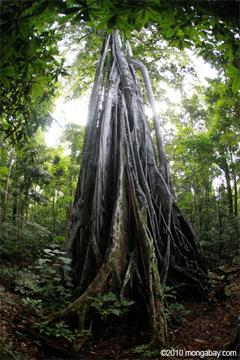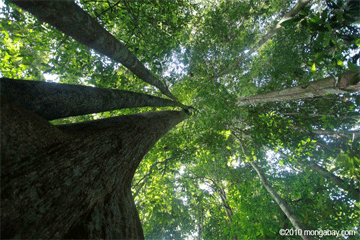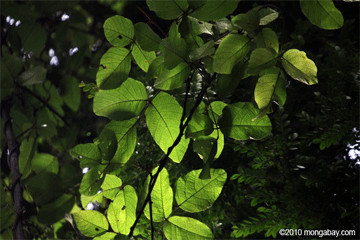Why biodiversity matters for carbon storage
Protection of forests for their carbon value through Reduced Emissions from Deforestation and Degradation (REDD) schemes has been increasing in recent years. These schemes concentrate on preserving forest cover, and thus have great potential for the conservation of natural biodiversity. Some (REDD+) initiatives already specifically take biodiversity protection into account.
There has been debate about the potential impacts of REDD schemes on biodiversity, given its potential to protect natural forests (1). However, where REDD projects are not well designed, they could fail to effectively protect the biodiversity within the forest itself; protecting these areas for their carbon value may not necessarily conserve their biodiversity value. Furthermore, relatively little is known about how such reductions in biodiversity may in turn affect the ability of a forest to store carbon (2).
 Tangkoko, Sulawesi in Indonesia |
The carbon storage value of a forest is essentially dependent on the trees within it photosynthesizing and storing carbon. Different plant species are more efficient at sequestering and storing carbon from the atmosphere. In general, large, slow growing trees with high wood densities tend to store the most carbon in the long term. When such a tree dies, much of the carbon stored within it will be released back into the atmosphere. Changes in biodiversity may directly, and indirectly, affect the likelihood of tree survival and thus carbon storage.
Potential impacts on biodiversity in carbon forests
Although habitat destruction remains a key global threat to biodiversity, simply protecting forest cover does not necessarily prevent a loss of the species within. If not managed effectively then threats such as uncontrolled hunting, selective logging or collection of non-timber forest products may alter both biodiversity levels and species composition. This will have direct impacts, but may also have indirect impacts on the resilience of the ecosystem, and thus its ability to store carbon in the long term (3). For example, one study suggested “Even forests whose trees received full protection from a program such as REDD could, over decades, lose carbon stocks through the ripple effects of bushmeat hunting on species interactions” (4).
Direct effects of biodiversity loss on carbon storage
REDD initiatives are designed to control threats related to trees, such as selective logging, fires or destructive collection of tree products. However, they may not necessarily protect against the loss or destruction of non timber plants or collection of animals. One of the most interesting examples of the potential impact of biodiversity loss on carbon storage is the case of hunting – be it for bushmeat or for commercial use – activities that are widespread across many forested areas.
|
|
Poaching often focuses on large bodied vertebrates, and thus removes species which tend to play critical functional roles in an ecosystem. Where top predators (such as tigers) are removed from a forest, this can result in an increase in herbivore abundance5 and in a forest context this may lead to over browsing of seedlings and prevent regeneration of trees. Similarly the removal of large herbivorous species (such as elephants), which would normally create small clearings as a result of their feeding behavior, has been linked to a decline in tree regeneration (6).
Bushmeat hunting of species which act as seed dispersers may result in a shift in tree species composition, and could ultimately alter carbon storage potential – although this process is still the subject of debate. Field studies in Thailand, Cameroon and Panama have found that 70%-90% of tree species rely on animal seed dispersal and that bushmeat hunting has a direct impact on tree species composition (4,6,7). In Cameroon and Thailand, the removal of large bodied seed dispersers was linked to the loss of larger seeded trees, which are often those that store the most carbon. However, others have questioned the impact of bushmeat hunting on carbon storage, given an associated reduction in seed predation8.
Changes in species composition – implications for carbon?
There is evidence that the loss of vertebrate seed dispersers can shift plant species composition towards those with wind dispersed seeds, such as lianas. This can result in a reduction in the net carbon stored in the forest.
For example, lianas grow quickly and are able to out-compete slower growing trees for both light, water and soil nutrients (9,10). This inhibits tree growth and regeneration, and increases tree mortality. An increase in lianas within a forest has been shown to negatively affect both the rate and volume of carbon storage. This occurs for two reasons: firstly while lianas out-compete trees, their thin stems and low wood density mean that they store relatively little carbon compared to the trees which they replace (10). Secondly, lianas will infest certain species preferentially, causing a shift in species composition to faster growing tree species, which often have lower wood density and store much less carbon (11). One model predicts a 34% decrease in carbon storage of a forest following liana infestation (2).
Biodiversity loss and ecosystem resilience
Unpredictable disturbances such as fires, natural disasters and invasive species introductions – and the ongoing changes to temperature or precipitation caused by climate change – all require ecosystems to adapt. Resilience of an ecosystem (its ability to recover from such impacts) is a key concern – as a degraded forest ecosystem quickly ceases to be a carbon sink and becomes a carbon source. High levels of biodiversity can provide ‘biological insurance’ against losses from disturbances, making the ecosystem more resilient and likely to recover, and allowing it to continue storing carbon in the long term (2). A 2009 report by the CBD supported this, stating that “within a given biome, diverse forests are more biologically productive and provide larger and more reliable carbon stocks, especially in old-age stable forest systems…Hence, protecting and restoring biodiversity serves to maintain resilience in forests, in time and space, and their ongoing capacity to reliably sequester and store carbon” (12).
For example, a large fire may destroy several dominant trees and plants, but quickly colonizing plant species will take their place, producing the appropriate environment to enable the subsequent recovery of larger, dominant species (2). This recovery is only possible if a diversity of species co-exist in the first place.
 Rainforest in Sumatra |
Similarly a biodiverse ecosystem is less likely to be severely damaged by the introduction of an invasive, exotic species. For example, an ecosystem with several natural predator species and a variety of plant species is likely to be less susceptible to the introduction of a non-native pest species (13,14). In a forest context this may help to prevent large insect invasions, which are often linked to tree die back. In a system of reduced biodiversity, invasions of pests may be a serious threat – and may result in tree mortality and loss of carbon storage function.
Resilience to the changing climate is also becoming a more important issue and biodiversity is likely to strengthen an ecosystem’s ability to survive without significant loss of above-ground carbon storage. One study concluded that biodiverse ecosystems in Panama are likely to show greater resilience to a drying climate as the presence of several drought tolerant species provides ‘biological insurance’ to counter the loss of other species2.
Additional indirect benefits of protecting biodiversity
Building biodiversity protection within REDD schemes adds extra value, beyond enhanced carbon protection (15). Maintaining biodiversity maintains other non- carbon functions of forests – for both local communities and wider ecosystem service benefits – including opportunities for sustainable harvests, but also maintenance of services such as water quality and pollination and erosion prevention.
|
Literature cited:
1 Freedman, B., G. Stinson, and P. Lacoul. 2009. Carbon credits and the conservation of natural areas. Environmental Reviews, 17: 1-19. 2 Bunker, D.E., DeClerck, F., Bradford, J.C., Colwell, R.K., Perfecto, I., Phillips, O.L., Sankaran, M., Naeem, S. (2005) Species loss and aboveground carbon storage in a tropical forest. Science 310 (5750), pp. 1029-1031 3 Diaz, S., Hector, A., and Wardle, D.A. (2009) Biodiversity in forest carbon sequestration initiatives: not just a side benefit. Current Opinion in environmental Sustainability 1: 55-60. 4 Brodie JF, Helmy OE, Brockelman WY, Maron JL. (2009) Bushmeat poaching reduces the seed dispersal and population growth rate of a mammal-dispersed tree Ecological Applications, 19(4), 2009, pp. 854–863 5 Lyons, K., Brigham, C., Traut, B., Schwartz, M. (2005 )Rare Species and Ecosystem Functioning. Conservation Biology, 19 (4) pp.1019-1024. 6 Maisels, F., Keming, E., Kemei, M., Toh, C. (2001) The extirpation of large mammals and implications for montane forest conservation: the case of the Kilum-ljim Forest, North-west Province, Cameroon Oryx Vol 35 No 4 7 Wright, S., Hernandez, A., Condit, R. (2007) The Bushmeat Harvest Alters Seedling Banks by Favoring Lianas, Large Seeds, and Seeds Dispersed by Bats, Birds, and Wind BIOTROPICA 39(3): 363–371 8 Jansen, P., Muller-Landau, H. and Wright, S. J.(2010) Bushmeat Hunting and Climate: An Indirect Link (Letter). Science 327 pp 30. 9 Phillips, O.L., Martinez, R.V., Arroyo, L., Baker, T.R., Killeen, T., Lewis, S.L., Malhi, Y., Mendoza, A.M., Neill, D., Vargas, P.N., Alexiades, M., Ceron, C., Di Fiore, A., Erwin, T., Jardim, A., Palacios, W., Saldias, M. and Vinceti, B. (2002) Increasing dominance of large lianas in Amazonian forests. Nature, 418 (6899). pp. 770-774. 10 Wright, S., Hernandez, A., Condit, R. (2007) The Bushmeat Harvest Alters Seedling Banks by Favoring Lianas, Large Seeds, and Seeds Dispersed by Bats, Birds, and Wind BIOTROPICA 39(3): 363–371 11 van der Heijden, G. M. F. and Phillips, O. L. (2009). Liana infestation impacts tree growth in a lowland tropical moist forest, Biogeosciences Discuss., 6, 3133-3158, 12 Thompson, I., Mackey, B., McNulty, S., Mosseler, A. (2009). Forest Resilience, Biodiversity, and Climate Change. A synthesis of the biodiversity/resilience/stability relationship in forest ecosystems. Secretariat of the Convention on Biological Diversity, Montreal. Technical Series no. 43, 67 pages. 13 Chapin III, F.S., Zavaleta, E.S., Eviner, V.T., Naylor, R.L., Vitousek, P.M., Reynolds, H.L., Hooper, D.U., , Díaz, S. (2000). Consequences of changing biodiversity. Nature 405 (6783), pp. 234-242 14 Juliano, S.A., Lounibos, L.P., Nishimura, N., Greene, K. (2010). Your worst enemy could be your best friend: Predator contributions to invasion resistance and persistence of natives Oecologia 162 (3), pp. 709-718 15 Diaz, S., Hector, A., and Wardle, D.A. (2009) Biodiversity in forest carbon sequestration initiatives: not just a side benefit. Current Opinion in environmental Sustainability 1: 55-60. |
Related articles
Scientists sound warning on forest carbon payment scheme

(07/22/2010) Scientists convening in Bali expressed a range of concerns over a proposed mechanism for mitigating climate change through forest conservation, but some remained hopeful the idea could deliver long-term protection to forests, ease the transition to a low-carbon economy, and generate benefits to forest-dependent people.
Destruction of old-growth forests looms over climate talks

(12/08/2009) Destruction of old-growth or primary forests looms large in discussions in Copenhagen over a scheme to compensate tropical countries for reducing emissions from deforestation and degradation (REDD). Some environmental groups are pressing for conservation of old-growth forests — the most carbon-dense, and biologically-rich state of forests — to be the centerpiece of REDD, while industry and other actors are pushing for “sustainable forest management” or logging using reduced-impact techniques to be the primary focus of REDD.
Cheap REDD isn’t the best conservation strategy for biodiversity
(12/03/2009) The lowest-cost approach to compensating reductions in emissions from deforestation and degradation under a proposed UN program (REDD) isn’t necessarily the best approach for biodiversity conservation, report researchers writing in the journal Science.
REDD shouldn’t neglect biodiversity say scientists
(07/30/2009) Schemes to mitigate climate change by protecting tropical forests must take into account biodiversity conservation, said two leading scientific organizations at the conclusion of a four day meeting in Marburg, Germany.








